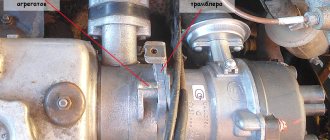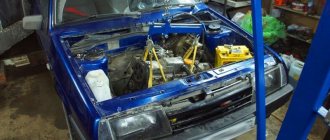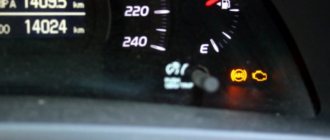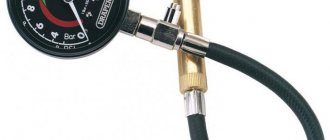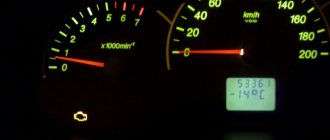Main reasons
The car starts to act up at speed
On the Lada there are hydraulic compensators on the valves; they automatically adjust the clearances in the valve mechanism. These devices are sensitive to oil starvation. As a result of a decrease in the level of this substance, fingers knock when accelerating the car. This knocking sound is also produced in the following situations:
- the filter or oil receiver in the crankcase is clogged,
- there is no operating pressure in the oil pump,
- Timing oil channels are clogged.
Jerking is another common problem that is associated with a short-term spontaneous change in engine speed regardless of the position of the accelerator pedal. In daily use, a whole series of jerks appear. An extreme case of this phenomenon - failures during acceleration of the Lada Priora - is a noticeable delay in the engine's response to pressing the accelerator pedal.
There are several reasons for jerking:
- when starting to move,
- when accelerating,
- with the accelerator pedal in constant position.
You can determine the reasons why a Lada with an injection engine stalls when accelerating using special diagnostic equipment. In most cases, jerking is caused by insufficient fuel pressure in the corresponding rail, a malfunction of the mass air flow sensor or the throttle position sensor.
Why can the speed fluctuate?
The injector, unlike carburetor injection, is fully controlled automatically through the engine control unit. Fuel is supplied to the combustion chamber under the action of a high-pressure pump and sprayed through nozzles, mixing with air that is captured from the environment; gasoline, mixed with air, forms the fuel mixture necessary for engine operation. The engine control unit determines the required amount of fuel based on the readings of the entrained air; the amount of air that entered the engine is calculated by the air flow sensor (MAF).
From the above, we can conclude that the slightest problems with the fuel or air supply can lead to unstable idling on the Priora.
List of reasons for floating revolutions:
- Air leak;
- DMRV malfunction;
- IAC malfunction;
- DU contamination;
- Poor fuel quality;
- Fuel pump malfunction;
- Clogged filters;
All these breakdowns are most often the cause of floating idle speed. To independently find the cause and eliminate it, you need to understand how to check and how to eliminate one of the problems. Let's look at each of the reasons in more detail to understand its meaning.
Air leak
All air drawn into the engine from the environment must be accounted for by the mass air flow sensor. If air is left out, the mixture will not mix at the correct consistency, resulting in an incorrect fuel mixture and therefore unstable idle speed.
Air leaks on a Priora can be at the junctions of the corrugation with the mass air flow sensor and the throttle assembly, at the idle air regulator, at the intake manifold (when adjacent to the cylinder head), at the injectors (rubber rings), at the dipstick. Leaking most often occurs due to aging o-rings on the receiver and injectors. Due to exposure to high temperatures from the engine, the rubber dries out and loses its properties, allowing air to pass through, which is not taken into account by the mass air flow sensor.
How to check air leaks can be studied in detail here.
DMRV malfunction
If the mass air flow sensor malfunctions, the air flow will not be calculated correctly, therefore, the fuel mixture will not be formed correctly, which will certainly lead to improper operation of the internal combustion engine, increased fuel consumption and other related problems.
You can learn how to quickly and easily check the mass air flow sensor on a Priora here.
IAC malfunction
The idle air control was installed on the VAZ 2110 and Priora, but until 2012. In the 12th year, Priora received an electronic throttle unit, which does not have throttle position and idle speed sensors.
The regulator is an electric motor that closes the air supply channel. A rubber ring is used as a seal between the remote control and the IAC, which serves to seal the system, which quite often gets lost or loses its properties.
More information about IAC can be found in this article.
Throttle body clogged
With high mileage in cars, crankcase gases begin to throw up oil, since in the Priora a small breather is connected to the intake corrugation, oil particles fall on the throttle assembly, namely its valve, and settle on it, thereby polluting it and creating resistance to air flow. A clogged throttle body can significantly affect engine performance.
https://enginehack.ru/chistka-drosselnoj-zaslonki-na-priore/You can learn how to clean the throttle valve yourself here.
Bad fuel
Fuel plays a huge role in engine performance. Just one refueling with low-quality fuel can seriously damage your car and practically break it. If the gasoline contains debris, its particles can clog the filter and stop the supply of fuel to the engine.
Clogged filters
Filters clean the fuel before it enters the engine. The more often a driver refuels at low-quality gas stations, the more he exposes his car to danger. Filters become clogged quite often due to low-quality fuel. It is recommended to replace filters every year before winter.
Fuel pump malfunction
As is known, for the injector to work, fuel must be supplied to the system under a certain pressure, which is pumped by the fuel pump. When this part fails, the fuel pressure does not reach the required parameters, which leads to unstable operation.
More information about the fuel pump can be found here.
Jerks when moving
The moment the car starts moving, most often there is a failure. Unpleasant sensations are associated with a delay in the engine's response to pressing the accelerator pedal. In some cases, the engine stalls. A jerk occurs when the throttle valve opens, when, based on a signal from its position sensor, the ECU determines the moment of transition from cold mode to load mode. This is aimed at increasing the amount of fuel supplied through the injectors. Due to insufficient pressure in the fuel line, there is not enough fuel to move the Lada Priora smoothly.
For this reason, the car stalls when accelerating. In this case, the electronic control unit of the engine, having received a message from the throttle position sensor about the intensive opening of the damper at a large angle, strives to increase the fuel supply as much as possible. This is impossible to do due to low fuel pressure.
During steady motion, jerking is caused by a malfunction of the ignition system. In this situation, the vehicle will need to be diagnosed and repaired. If this problem occurs on the road, then auto mechanics advise Lada Priora owners to follow these steps:
Maximum acceleration of Lada
- inspect the space under the hood - turn off the ignition, and then check that the wiring harness blocks are securely attached to the ignition coils. You need to start the engine, listening to its operation: the crackling sound during a high voltage breakdown is weak, but clear. In complete darkness, a spark should be visible upon breakdown,
- Replace spark plugs regardless of mileage and condition. You need to pay attention to the condition of the spark plugs: if it is abnormal, then you will need to repair the engine or its elements. Causes jerking during steady movement of Lada with an injector, a possibly faulty throttle position sensor. Additional reasons confirming the malfunction of this unit are: uneven operation of the engine at idle, reduction in maximum engine power.
Return to contents
Why doesn't the engine rev up? Possible causes and methods of eliminating them
Lack of engine speed when pressing the gas pedal is a common problem that most drivers have encountered. There are many reasons for this unpleasant situation: it can be either a transition from a gasoline engine to gas-cylinder equipment, or a simple engine malfunction. Let's study the reasons in more detail.
The engine does not pick up speed when you press the gas pedal: reasons
First of all, you need to pay attention to the “symptoms” of the problem: when it manifests itself, how, and whether there are additional signals indicating a malfunction. It is quite possible that the engine is fully operational and is being prevented from functioning normally by a sensor that was disconnected during repairs. The technician can fix this problem after a short inspection.
If engine failures occur without any serious reasons, careful diagnostics are required.
Let's take a closer look at the reasons that the car owner can correct himself.
A key factor in reliable engine operation is the quality of the fuel mixture, the characteristics of its flow, ignition and combustion in the working area of the engine. Violation of any of the above processes leads to problems with engine speed. That is why, in case of failures in the internal combustion engine, the first thing you should pay attention to is the operation of the fuel and oxygen supply system.
- If dirt, a mixture of oil and sand has accumulated in the air filter, air will penetrate into the engine unevenly, which will lead to a loss of engine power and, accordingly, to “missed” revolutions.
2. Malfunction of the intake system leads to excessive air leaks. The failure may occur suddenly, or it may become chronic. The intake of a large amount of air depletes the mixture, and there are too few flammable vapors in it. In this case, the engine starts, but during the trip the car cannot reach the required speed.
3. Lack of fuel in the engine. This problem most often occurs due to a clogged filter. There is enough fuel to start the engine, but it is no longer enough for normal driving. As a result, the car jerks and does not respond well to the gas pedal. During the increase in speed, so-called “dips” are observed. 4. Accumulation of dirt on the fuel pump filter. The filter is a small mesh; when oily deposits get on it, the pressure in the system increases and a sufficient amount of fuel does not enter the combustion chamber. When the fuel pump filter becomes dirty, the engine begins to operate intermittently in almost all modes. When trying to gain speed, the internal combustion engine may simply stall.
5.
Problems with spark plugs or electrical wiring, leading to problems with ignition of the combustible mixture. In this case, the fuel ignites at the wrong time, the engine loses power, and the system is unable to gain speed. The spark plugs may become oily and dirt may accumulate on them. Common causes of spark plug malfunctions include damage to the casing and incorrect setting of the electrode gaps.
6.
Broken electrical wires connected to the spark plugs. In this case, the engine troits, and the engine gains speed with great reluctance.
Correcting these problems is not difficult: you need to check whether the spark plugs and wires are sparking; look at the pressure level on the fuel rail pressure gauge; remove oily deposits and dirt from the air filter; change the fuel filter to a new one; clean the fuel pump screen, etc. from dirt deposits.
Engine speed may also drop for more complex reasons, which cannot be eliminated on your own, since repairs require special knowledge, experience and the availability of diagnostic equipment.
You cannot do without the help of a car service if:
- Failure in the timing of the car's gas distribution mechanism. If the timing of the engine is disrupted, the fuel intake and exhaust gases are uneven, and the valves open intermittently. A similar problem often arises after poor-quality repairs such as replacing the timing belt, improper valve adjustment, malfunctions of the valve timing system, and failure of the timing chain.
- Malfunction of the coils or ignition module. The main “sign” of this problem is that the engine begins to stall, misfires are observed in the cylinder system, and the number of revolutions decreases.
- Malfunctions in the power supply of the injector nozzles. The most common cause of this problem is poor wiring. The electrical signal does not reach the injector or does not reach it at the right time. Naturally, under such conditions, the injector cannot work correctly, which is why the fuel ignites unevenly in the cylinders, and engine power drops along with the speed.
- Problems with the fuel pump. An unpleasant breakdown that develops slowly but inevitably. As a result, the pressure created will not be enough to operate the engine: the engine will stall.
- Dirt getting into the injector. This problem can be caused by the use of low-quality fuel and contamination of the injectors. It is recommended to clean the injectors after 35-45 thousand km. mileage
- Unsatisfactory condition of the systems responsible for the removal of gases, primarily the USR, soot filters and catalyst. A large amount of carbon dioxide remains in the engine and the engine is not able to gain the required number of revolutions under such conditions.
- Failure of the electronic control system devices of the internal combustion engine, leading to a change in the composition of the combustible mixture.
- A breakdown of the electronic control unit cannot be ruled out. This problem can occur after poor-quality firmware repair. The main signal of a problem in the ECU is the jerky operation of the engine, an unexpected increase and drop in torque.
Timely implementation of simple service procedures such as cleaning the injector, replacing spark plugs or filters is an excellent prevention of any engine problems.
For a gas car, the correct settings of the engine and fuel supply system are key.
Signs of engine tripping
Regardless of the reasons, engine tripping is associated with the presence of various problems, which can be solved after finding out what caused the stoppage of one of the cylinders of the internal combustion engine.
The main signs of engine tripping include
Signs
Auto mechanics identify several reasons why jerking occurs and the engine begins to stall. The main ones are: incorrect ignition timing, faulty spark plugs and installed condenser, broken piston rings, piston and valve burnout, rocker wear, clogged air filter, and others.
The cause of the jerking must be sought in the cylinders
To reduce the search for the cause of engine tripping, it is recommended to determine which cylinders are not working correctly or have stopped functioning. To do this, you will need to remove the high-voltage wire from the spark plugs one by one. This procedure must be performed carefully, as there is a risk of electric shock. Before performing this work, you will need to place a dielectric base in the form of rubber or wood under your feet. It is recommended to remove by the wire. Then the engine speed increases to 1500 rpm. The valves are removed from the cylinders one by one. If the sound of the vehicle changes when removed, then the cylinder is working correctly. Otherwise, it must be replaced.
Inspection of high voltage wire
Often, the Priora stalls when accelerating due to a malfunction of the ignition system. This is especially true for the condition of the high-voltage wire leading to the spark plug. To inspect it, you will need to remove the tip attached to the spark plug. The structure of a high-voltage wire is as follows: the winding contains the central core of the wire. The tip, which is put on the candle, has a persistent metal penny. The main purpose of this element is to transmit current to the spark plug.
The core of the high-voltage wire should fit as tightly as possible to the “penny” of the steel tip placed on the spark plug. Due to aging, contact between this element and the wire may be lost due to oxidation of the metal. As a result, tripling occurs. The oxidation of the contact is checked as follows: with the second probe of the multimeter, you should touch the central core of the high-voltage wire; if the core of the high-voltage wire burns out along its entire length, then it is possible to identify such a section using a special multimeter tip.
The wire is pierced until the affected area is identified every 5-10 mm. If such a section is detected, it is cut off if the length of the high-voltage wire allows it. Otherwise, it needs to be replaced.
The car doesn't start well
If the car doesn't start well when it's cold, it means it's not all that bad. The reasons are completely removable even at home. As a rule, the problems lie in the following:
- disgusting quality of gasoline. If the gas station overdilutes it, there will be too much water in the tank. Try visiting another gas station;
- ignition problems. It is often difficult to start the engine due to problems with high-voltage wires and spark plugs;
- oxygen sensor malfunction.
One of the most popular cars on the Russian market produced by AvtoVAZ is the budget car LADA Priora. As is typical for all cars, Priora has undergone many improvements and changes since its entry into the market, but unfortunately its vulnerabilities remain. Therefore, the weaknesses, diseases and shortcomings of the domestic car Lada Priora will be considered further. In this material there will be no mention of the engine and gearbox, since there are cases of failure of individual elements of these units, but this is not a widespread phenomenon.
Replacing spark plugs yourself
Replacing spark plugs on a Lada
Since faulty spark plugs occur most often during acceleration failures, auto mechanics recommend Lada Priora owners learn how to change this element of the ignition system themselves. This should be done after the car has traveled 20 thousand km. However, if the engine starts to trip, the spark plugs should be replaced before this date:
- Initially, you will need to clean the engine compartment from dirt and debris,
- Next, it is necessary to dismantle the engine elements to gain unhindered access to the spark plugs. Adapters and extensions are used for this. Before performing this work, you will need to wait until the engine has completely cooled down.
- The spark plugs are unscrewed one by one, and the high-voltage wires are disconnected. To prevent an accident, you must first remove the battery from the car. Otherwise, electricity may be supplied. When performing this procedure, it is recommended to monitor the force applied. It is better to seek help from specialists if the candle does not budge.
- To prevent debris from getting into the resulting holes, you need to cover them,
- The candles are screwed in manually at the first stage. Next, they are tightened using a special mechanism that allows you to measure the amount of force applied,
- high voltage wires are connected,
- engine operation is checked,
- The previously dismantled elements are assembled in the reverse order.
To ensure stable engine operation, spark plugs should be replaced regularly.
Often, Lada Priora car owners notice that their vehicle jerks when accelerating when pressing the gas pedal. Such dips are felt only when you sharply press the gas and at low speeds. In such a situation, it is recommended to check the idle speed sensor, throttle level position, and spark plugs for serviceability.
Loss of traction not related to the engine
The engine is the tireless heart of the car
If the engine operation does not raise suspicions and the car does not pull, then this indicates a clutch malfunction. Destruction of the clutch plate lining or damage to the springs leads to the fact that the clutch transmits torque from the engine to the gearbox only partially, and clutch slippage occurs.
With such a malfunction, any car, including Priora, pulls very poorly.
It is quite easy to identify this malfunction. When slipping occurs, the driven disk linings overheat greatly and a specific smell appears. The malfunction is eliminated by replacing worn or damaged clutch elements.
Main reasons
The car starts to act up at speed
On the Lada there are hydraulic compensators on the valves; they automatically adjust the clearances in the valve mechanism. These devices are sensitive to oil starvation. As a result of a decrease in the level of this substance, fingers knock when accelerating the car. This knocking sound is also produced in the following situations:
- the filter or oil receiver in the crankcase is clogged,
- there is no operating pressure in the oil pump,
- Timing oil channels are clogged.
Jerking is another common problem that is associated with a short-term spontaneous change in engine speed regardless of the position of the accelerator pedal. In daily use, a whole series of jerks appear. An extreme case of this phenomenon - failures during acceleration of the Lada Priora - is a noticeable delay in the engine's response to pressing the accelerator pedal.
There are several reasons for jerking:
- when starting to move,
- when accelerating,
- with the accelerator pedal in constant position.
You can determine the reasons why a Lada with an injection engine stalls when accelerating using special diagnostic equipment. In most cases, jerking is caused by insufficient fuel pressure in the corresponding rail, a malfunction, or a malfunction of the throttle position sensor.
Jerks when moving
The moment the car starts moving, most often there is a failure. Unpleasant sensations are associated with a delay in the engine's response to pressing the accelerator pedal. In some cases, the engine stalls. A jerk occurs when the throttle valve opens, when, based on a signal from its position sensor, the ECU determines the moment of transition from cold mode to load mode. This is aimed at increasing the amount of fuel supplied through the injectors. Due to insufficient pressure in the fuel line, there is not enough fuel to move the Lada Priora smoothly.
For this reason, the car stalls when accelerating. In this case, the electronic control unit of the engine, having received a message from the throttle position sensor about the intensive opening of the damper at a large angle, strives to increase the fuel supply as much as possible. This is impossible to do due to low fuel pressure.
During steady motion, jerking is caused by a malfunction of the ignition system. In this situation, the vehicle will need to be diagnosed and repaired. If this problem occurs on the road, then auto mechanics advise Lada Priora owners to follow these steps:
Maximum acceleration of Lada
- inspect the space under the hood - turn off the ignition, and then check that the wiring harness blocks are securely attached to the . You need to start the engine, listening to its operation: the crackling sound during a high voltage breakdown is weak, but clear. In complete darkness, a spark should be visible upon breakdown,
- Replace spark plugs regardless of mileage and condition. You need to pay attention to the condition of the spark plugs: if it is abnormal, then you will need to repair the engine or its elements. Causes jerking during steady movement of Lada with an injector, a possibly faulty throttle position sensor. Additional reasons confirming the malfunction of this unit are: uneven operation of the engine at idle, reduction in maximum engine power.
Loss of traction due to a malfunction of the ignition system
Next, you should check the ignition system of the Lada Priora. The glow plugs are checked first. They must supply a spark to the cylinder at the right moment. If you notice interruptions in the operation of the spark plug, you should also check the ignition coil, which supplies voltage to the faulty spark plug; it is quite possible that the fault lies there.
After checking the spark plugs and coils, you need to pay attention to the crankshaft and camshaft position sensors. Incorrect data from these sensors, which they transmit to the control unit, can cause interruptions in engine performance. If interruptions in the functioning of these sensors are detected, they are replaced.
The last thing to check in the ignition system is the electronic control unit (ECU), since it is responsible for the fuel supply and the correct spark timing. A malfunction in its operation often leads to a significant loss of power. In some cases, in order to restore the functionality of the ECU, it is necessary to flash its firmware. Often the firmware removes the problem of loss of power from the power plant. But there are also cases when the control unit needs to be replaced.
Signs of engine tripping
Regardless of the reasons, engine tripping is associated with the presence of various problems, which can be solved after finding out what caused the stoppage of one of the cylinders of the internal combustion engine.
The main signs of engine tripping include:
- uneven operation at idle, as well as shaking of the engine,
- darkening of one of the spark plugs,
- change in exhaust sound,
- poor acceleration dynamics of the Priora at any speed,
- increased fuel consumption,
- floating revolutions, displayed on the tachometer by twitching the arrow,
- jerking when accelerating or driving.
Auto mechanics identify several reasons why jerking occurs and the engine begins to stall.
The main ones are: incorrect ignition timing, faulty spark plugs and installed condenser, broken piston rings, piston and valve burnout, rocker wear, clogged air filter, and others.
The cause of the jerking must be sought in the cylinders
To reduce the search for the cause of engine tripping, it is recommended to determine which cylinders are not working correctly or have stopped functioning. To do this, you will need to remove the high-voltage wire from the spark plugs one by one. This procedure must be performed carefully, as there is a risk of electric shock. Before performing this work, you will need to place a dielectric base in the form of rubber or wood under your feet. It is recommended to remove by the wire. Then the engine speed increases to 1500 rpm. The valves are removed from the cylinders one by one. If the sound of the vehicle changes when removed, then the cylinder is working correctly. Otherwise, it must be replaced.
Inspection of high voltage wire
Often, the Priora stalls when accelerating due to a malfunction of the ignition system. This is especially true for the condition of the high-voltage wire leading to the spark plug. To inspect it, you will need to remove the tip attached to the spark plug. The structure of a high-voltage wire is as follows: the winding contains the central core of the wire. The tip, which is put on the candle, has a persistent metal penny. The main purpose of this element is to transmit current to the spark plug.
The core of the high-voltage wire should fit as tightly as possible to the “penny” of the steel tip placed on the spark plug. Due to aging, contact between this element and the wire may be lost due to oxidation of the metal. As a result, tripling occurs. The oxidation of the contact is checked as follows: with the second probe of the multimeter, you should touch the central core of the high-voltage wire; if the core of the high-voltage wire burns out along its entire length, then it is possible to identify such a section using a special multimeter tip.
The wire is pierced until the affected area is identified every 5-10 mm. If such a section is detected, it is cut off if the length of the high-voltage wire allows it. Otherwise, it needs to be replaced.
Replacing spark plugs yourself
Replacing spark plugs on a Lada
Since faulty spark plugs occur most often during acceleration failures, auto mechanics recommend Lada Priora owners learn how to change this element of the ignition system themselves. This should be done after the car has traveled 20 thousand km. However, if the engine starts to trip, the spark plugs should be replaced before this date:
- Initially, you will need to clean the engine compartment from dirt and debris,
- Next, it is necessary to dismantle the engine elements to gain unhindered access to the spark plugs. Adapters and extensions are used for this. Before performing this work, you will need to wait until the engine has completely cooled down.
- The spark plugs are unscrewed one by one, and the high-voltage wires are disconnected. To prevent an accident, you must first remove the battery from the car. Otherwise, electricity may be supplied. When performing this procedure, it is recommended to monitor the force applied. It is better to seek help from specialists if the candle does not budge.
- To prevent debris from getting into the resulting holes, you need to cover them,
- The candles are screwed in manually at the first stage. Next, they are tightened using a special mechanism that allows you to measure the amount of force applied,
- high voltage wires are connected,
- engine operation is checked,
- The previously dismantled elements are assembled in the reverse order.
To ensure stable engine operation, spark plugs should be replaced regularly.
Guys, do you have any thoughts? Priora 2009 I bought it in 2015. I drove it for a week, I realized that it wasn’t driving at all, before that I drove Priors, I know how they should drive. What was done: Replaced pistons with stock (butt-in) 82.0 E Block was not sharpened (measured) perfect cylinders without ellipse, original hone) Main bearings Connecting rod bearings DPDZ about 5 pieces of new IACs, about 4 pieces of new ones Cleaned the throttle 4 times Checked for new suction Mass air flow sensor Air filter New Bosch 022 injectors Gasoline filter Gasoline pump removed new mesh Rail pressure 3.9 whether hot or cold The computer was changed (mine was soldered with something) they installed it from the Niva 797+ and it went like that After that I changed the timing rollers, nothing but Without touching it, I drove out of the garage and still didn’t move. Afterwards we checked the marks 4 times, everything is in place! There were rollers from 12 pulleys with shoulders, I installed the same ones, although the pump was Priorov’s and the shaft gears were also Priorov’s and the belt. I don’t know why this is so, they were collective farmers before me. After that)))) Detonation began after it warms up for about half an hour and sits at idle, you start driving and it starts to detonate, drive about 3 km and it goes away. UOZ at the same time, according to diagnostics, 13 It was decided to open it...))) Once opened, the pistons dangle a little back and forth, but this is normal for a Priora. Completely overhauled the head, installed new valves, shafts, seals, and treated it with Loctite. Some hydraulic valves make noise, I haven't changed them. I installed the original timing rollers from Priora. (The belt is very displaced towards the block, it runs along the very edges of the rollers and a dotted line appears on it, it’s getting stuck somewhere, I’ll take a look) Oh yes, 3 clutch sets were changed, it twitched a lot when starting off, I didn’t know what was wrong. I changed the flywheel, in the end I sharpened the old original flywheel and installed everything. Spark plugs 4 sets changed, one coil Alternator belt roller Alternator bearings Starter rebuilt Retractor Brake discs Pads Clutch cable Gaskets under the intake manifold I installed the spider, then I put the catalytic converter back, because the sound is terrible, I didn’t notice the difference. Euro 2 was flashed. Lambda was turned off, no difference. In short, I don’t have any more strength... The car is practically new))) All this took about 100,000. Maybe someone will say that I’m sick, but I can’t drive a car when it doesn’t drive at all. It gains power very slowly and when you throw 4th gear at 80 to the floor, there is some kind of intrauterine hum and it gains power very slowly. In short, after assembling the head and installing it, the clutch began to twitch))))) Just like that, after 3 days of sitting in the garage, they didn’t go anywhere to the clutch at all. In short, remove the box, the primary and crankshaft oil seal runs. Changed the result zero (((((((((Help... P/S: who needs advice on repairing priors, please contact)))
Jerking when starting to move
At the moment the movement begins, the limiting case of a jerk—failure—most often occurs. The most unpleasant sensations are associated precisely with the delay in the engine's response to pressing the accelerator pedal. Sometimes the engine even stalls. A jerk occurs at the moment the throttle valve begins to open, when, based on a signal from the throttle position sensor, the ECU determines the moment of transition from idle mode to load mode and must increase the amount of fuel supplied through the injectors. If the pressure in the fuel line is insufficient (even if the injection duration is increased), there is not enough fuel for a smooth start.
Jerks during acceleration
The cause of jerking during acceleration may be, as in the previous case, insufficient fuel pressure in the fuel line. The electronic engine control unit, having received a signal from the throttle position sensor about the intensive opening of the throttle at a large angle, strives to maximize the fuel supply, but due to the reduced fuel pressure it is not able to do this. The reasons for this phenomenon and the method of verification are the same as in the previous case.
Jerks during steady motion
Such jerking is most often caused by a malfunction of the ignition system. Diagnostics and repair are necessary (see “Ignition system”). Along the way, you can try the following on your own:
– carefully inspect the engine compartment. Turn off the ignition and check that the wiring harness connectors are securely attached to the ignition coils. Start the engine and listen to its operation: the crackling sound when the high voltage breaks down to ground is weak, but distinct. In complete darkness, the spark during breakdown is clearly visible;
– replace spark plugs regardless of their condition and mileage. Pay attention to the condition of the spark plugs: if they are abnormal, the engine or its systems may need to be repaired. A specific cause of jerking during steady motion of a car with an injection engine may be sensor failure
Why the engine does not gain momentum: from simple to complex
At the very beginning, let's look at simpler and more obvious faults. The set of revolutions while driving is greatly influenced by the efficiency of delivery, the timing of ignition and the completeness of combustion, as well as the composition of the fuel-air mixture.
A common reason why an engine does not pick up speed (injector, carburetor, diesel, gas car) is problems in the ignition system, as well as in the air and fuel supply systems. Experts highlight the following:
- Severe contamination of the air filter reduces the ability of air to penetrate through the filter element, as a result of which the engine becomes uneven, the unit loses power and does not gain speed. Another common cause of air supply problems may be that a foreign object (rag, plastic bag, etc.) may accidentally end up in the air filter housing.
- You should also pay attention to the leakage of excess air at the intake as a result of various defects in the intake system. The problem can appear unexpectedly or gradually progress. Note that the engine usually does not gain speed in case of strong air leaks. The fact is that in the composition of the fuel-air mixture, the normal ratio of air and fuel in such a situation noticeably deviates from the norm. The mixture turns out to be very “lean” (lots of air and minimal fuel). With such a charge, the engine starts, but does not gain speed while driving, and also runs intermittently.
- A similar picture can be observed when the required amount of fuel is not supplied to the unit. The culprit may be the fuel filter, which can also become severely clogged. Note that there may be no problems with starting the engine, since there is enough fuel for the XX mode. At the same time, while driving, the car may twitch, react to pressing the gas pedal with a long delay, dips may occur when the speed increases, or the unit may not spin above a certain mark on the tachometer.
- A dirty fuel pump mesh filter can also lead to similar symptoms. Deposits from the fuel tank tend to accumulate on this filter over time. As a result, the fuel pressure in the system becomes insufficient, the pump performance drops, and the engine itself is not able to operate normally in different modes. It often happens when the engine picks up speed and stalls precisely because the grid is clogged.
Now let's talk about problems that may require certain knowledge, skills and equipment for diagnosis, and also be a reason for a visit to a car service center. Let's start with the fact that this list of faults usually includes those when the engine does not gain speed due to the failure of any element of the ECM, ignition system, power supply, etc. In other words, we are no longer talking about “consumables” (spark plugs, wires, filters, pipes), but about details. In parallel with this, one should also take into account whether the breakdown occurred unexpectedly or whether the fault progressed gradually.
- One of the reasons may be misaligned timing. Violations of the synchronous operation of the gas distribution mechanism regarding the intake and exhaust strokes lead to the fact that the intake and exhaust valves open untimely. The malfunction occurs as a result of errors during timing belt replacement if said timing belt has jumped one tooth or more teeth. Also, the cause may be incorrectly adjusted valves (the problem does not manifest itself sharply), various problems in variable valve timing systems, breakdown of the timing chain drive, etc.
- Unexpected breakdowns include failure of the ignition module, as well as malfunctions of the ignition coils. In this case, the cylinders begin to misfire, the engine stalls and loses the ability to gain speed normally.
- In situations with engine speed, the power supply to the injection nozzles should be checked. If problems arise with the wiring, then the control signal is not supplied to the injector or is received intermittently. As a result, the injector does not open in a timely manner, misfires occur in one or more cylinders, the engine does not reach the required speed and loses power.
- The fuel pump or fuel injection pump on diesel engines may fail. This problem usually does not occur immediately (except in cases where the electrical wiring to the pump is damaged). Much more often, the decrease in pump performance occurs gradually. Sooner or later, the pump will begin to pump fuel very weakly; the pressure will only be enough to operate in idle mode. An increase in load and speed will lead to the engine stalling under load, not spinning up, etc.
- In some cases, severe contamination of the injector itself leads to similar results. Driving on low-quality fuel, as well as ignoring the necessary procedure for cleaning injectors every 30-40 thousand kilometers driven, can mean that the performance of one or more fuel injectors has dropped significantly.
- Engine speed can also be affected by the condition of the EGR system, the throughput of the catalyst or particulate filter. As for the second case, due to a clogged catalyst, exhaust gas removal deteriorates, the engine literally “suffocates” and is not able to gain normal speed.
- At the same time, it is necessary to check various sensors of the electronic engine management system. Their incorrect operation can affect the composition of the mixture, that is, the amount of fuel and air supplied to the internal combustion engine. Such sensors include TPS, DMRV and a number of others.

